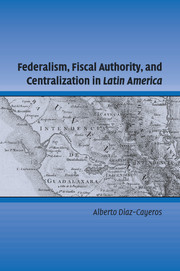Book contents
- Frontmatter
- Contents
- List of Figures
- List of Tables
- Preface
- Federalism, Fiscal Authority, and Centralization in Latin America
- 1 FEDERALISM, PARTY HEGEMONY, AND THE CENTRALIZATION OF FISCAL AUTHORITY
- Part I Fiscal Centralization in Mexico
- Part II Centralization and Revenue-Sharing in the Latin American Federations
- 6 VENEZUELA: UNITARIANISM IN DISGUISE
- 7 ARGENTINA: REGIME CHANGE AND FRAGILE CREDIBILITY
- 8 BRAZIL: THE RETENTION OF FISCAL AUTHORITY
- 9 CONCLUSION: STATE-BUILDING, POLITICAL INSTITUTIONS, AND FISCAL AUTHORITY
- References
- Index
- Titles in the Series
8 - BRAZIL: THE RETENTION OF FISCAL AUTHORITY
Published online by Cambridge University Press: 08 January 2010
- Frontmatter
- Contents
- List of Figures
- List of Tables
- Preface
- Federalism, Fiscal Authority, and Centralization in Latin America
- 1 FEDERALISM, PARTY HEGEMONY, AND THE CENTRALIZATION OF FISCAL AUTHORITY
- Part I Fiscal Centralization in Mexico
- Part II Centralization and Revenue-Sharing in the Latin American Federations
- 6 VENEZUELA: UNITARIANISM IN DISGUISE
- 7 ARGENTINA: REGIME CHANGE AND FRAGILE CREDIBILITY
- 8 BRAZIL: THE RETENTION OF FISCAL AUTHORITY
- 9 CONCLUSION: STATE-BUILDING, POLITICAL INSTITUTIONS, AND FISCAL AUTHORITY
- References
- Index
- Titles in the Series
Summary
Resilient Federalism
In contrast with Venezuela, Argentina, and Mexico, the fiscal pact in Brazil did not involve a centralized federal commitment. States in Brazil successfully resisted the pressures for centralization from the federal government, retaining a highly peripheralized fiscal arrangement. The precedents of revenue-sharing date back to the 1930s, which would suggest a development parallel to Argentina and Mexico. However, in Brazil the federal bargain did not become centralized. Federal transfers to the states and municipalities did not become firmly established until the 1960s, after the collapse of democracy, and a substantial amount of fiscal authority always remained controlled by the states.
Most discussions of Brazilian federalism suggest that decentralization has varied according to the political regime. Military rulers in Brazil tried to centralize taxation by controlling the most important sources of revenue and granting the federal government the residual power to create new taxes (Varsano, 1996; Abrucio, 1998). This was not unlike efforts by Getulio Vargas, within the authoritarian Estado Novo, to centralize revenue after 1937. However, what is striking about Brazil is not the variation in centralization but that state politicians remained – as they did with Vargas – too strong to subdue. The efforts at unitarian imposition of both Vargas and the military in the 20th century largely failed. Vargas had to concede the sales tax to the states, and could not strip from them the power to tax exports. The military had to allow the states to retain control of the value-added tax.
- Type
- Chapter
- Information
- Publisher: Cambridge University PressPrint publication year: 2006



